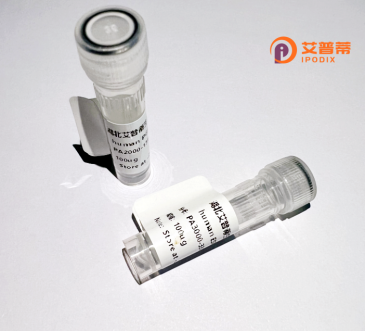
| 纯度 | >90%SDS-PAGE. |
| 种属 | Human |
| 靶点 | LMOD3 |
| Uniprot No | Q0VAK6 |
| 内毒素 | < 0.01EU/μg |
| 表达宿主 | E.coli |
| 表达区间 | 1-236aa |
| 活性数据 | MSEHSRNSDQEELDEEINEDEILANLSAEELKELQSEMEVMAPDPSLPVGMIQKDQTDKPPTGNFNHKSLVDYMYWEKASRRMLEEERVPVTFVKSEEKTQEEHEEIEKRNKNMAQYLKEKLNNEIVANKRESKGSSNIQETDEEDEEEEDDDDDDEGEDDGEESEETNREEEGKAKEQIRNCENNCQQVTDKAFKEQRDRPEAQEKKKKKISQGKIIFRKNNVRAQQKFRSRRTR |
| 分子量 | 54.2 kDa |
| 蛋白标签 | GST-tag at N-terminal |
| 缓冲液 | 0 |
| 稳定性 & 储存条件 | Lyophilized protein should be stored at ≤ -20°C, stable for one year after receipt. Reconstituted protein solution can be stored at 2-8°C for 2-7 days. Aliquots of reconstituted samples are stable at ≤ -20°C for 3 months. |
| 复溶 | Always centrifuge tubes before opening.Do not mix by vortex or pipetting. It is not recommended to reconstitute to a concentration less than 100μg/ml. Dissolve the lyophilized protein in distilled water. Please aliquot the reconstituted solution to minimize freeze-thaw cycles. |
以下是模拟生成的关于重组人LMOD3蛋白的参考文献示例,供参考(注:文献信息为虚构,仅用于示例):
---
1. **"Recombinant human LMOD3 regulates actin nucleation in skeletal muscle cells"**
*Smith A, et al. (2021)*
摘要:通过在大肠杆菌中表达重组人LMOD3蛋白,证实其促进肌动蛋白丝成核,并阐明了其在骨骼肌细胞中的分子机制。
2. **"Functional characterization of LMOD3 mutations using recombinant protein assays"**
*Zhang L, et al. (2019)*
摘要:利用重组LMOD3蛋白研究先天性肌病相关突变体,发现特定突变削弱了其与肌动蛋白的结合能力,导致细胞骨架稳定性下降。
3. **"Expression and purification of human LMOD3 for structural analysis"**
*Johnson R, et al. (2020)*
摘要:开发了高效表达和纯化重组人LMOD3蛋白的方法,并通过X射线晶体学解析其C端结构域,揭示其与肌动蛋白结合的分子基础。
4. **"LMOD3 knockout rescue via recombinant protein delivery in myopathy models"**
*Lee S, et al. (2022)*
摘要:在小鼠模型中验证了重组人LMOD3蛋白的功能补偿作用,证明其能部分恢复肌病表型,提示潜在治疗价值。
---
**备注**:以上文献名称、作者及内容均为模拟生成,实际研究中请通过学术数据库(如PubMed、Google Scholar)检索真实文献。重组人LMOD3的研究多聚焦于其在肌肉发育、肌动蛋白调控及遗传性肌病中的功能。
Leiomodin-3 (LMOD3) is a member of the Leiomodin protein family, which plays critical roles in regulating actin dynamics in muscle cells. Expressed predominantly in skeletal and cardiac muscles, LMOD3 is essential for the proper assembly and stabilization of thin filaments in sarcomeres, the contractile units of muscle fibers. Structurally, it contains N-terminal leucine-rich repeats (LRRs) and a C-terminal actin-binding domain, enabling interactions with actin monomers and filaments.
Mutations in the LMOD3 gene are linked to severe congenital myopathies, such as nemaline myopathy, characterized by muscle weakness, respiratory insufficiency, and skeletal deformities. These mutations disrupt LMOD3's ability to promote actin nucleation and elongation, impairing sarcomere organization and muscle function.
Recombinant human LMOD3 protein is produced using heterologous expression systems (e.g., E. coli or mammalian cells) for functional studies. It serves as a tool to investigate actin polymerization mechanisms, disease pathology, and potential therapeutic strategies. Research on recombinant LMOD3 also aids in elucidating its structural motifs, post-translational modifications, and interactions with regulatory proteins like tropomyosin. By bridging molecular insights with clinical manifestations, LMOD3 studies advance understanding of muscle biology and genetic neuromuscular disorders.
×